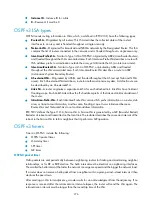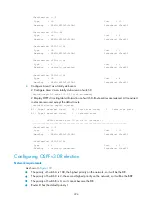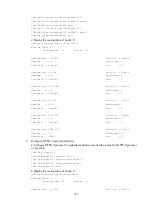
289
•
To implement area-based IPsec protection, you need to configure the same IPsec policy on the
routers in the target area.
•
To implement interface-based IPsec protection, you need to configure the same IPsec policy on the
interfaces between two neighboring routers.
•
To implement virtual link-based IPsec protection, you need to configure the same IPsec policy on the
two routers connected over the virtual link.
If an interface and its area each have an IPsec policy configured, the interface uses its own IPsec policy.
If a virtual link and area 0 each have an IPsec policy configured, the virtual link uses its own IPsec policy.
Configuration prerequisites
Before you apply an IPsec policy for OSPFv3, complete following tasks.
•
Create an IPsec proposal.
•
Create an IPsec policy.
For more information about IPsec policy configuration, see
Security Configuration Guide
.
Configuration guidelines
An IPsec policy used for OSPFv3 can only be in manual mode. For more information, see
Security
Configuration Guide
.
Configuration procedure
To apply an IPsec policy in an area:
Step Command
Remarks
1.
Enter system view.
system-view
N/A
2.
Enter OSPFv3 view.
ospfv3
[
process-id
]
N/A
3.
Enter OSPF area view.
area
area-id
N/A
4.
Apply an IPsec policy in the
area.
enable ipsec-policy
policy-name
Not configured by default.
To apply an IPsec policy on an interface:
Step Command
Remarks
1.
Enter system view.
system-view
N/A
2.
Enter interface view.
interface
interface-type
interface-number
N/A
3.
Apply an IPsec policy on the
interface.
ospfv3 ipsec-policy
policy-name
[
instance
instance-id
]
Not configured by default
To apply an IPsec policy on a virtual link:
Step Command
Remarks
1.
Enter system view.
system-view
N/A
2.
Enter OSPFv3 view.
ospfv3
[
process-id
]
N/A
3.
Enter OSPF area view.
area
area-id
N/A






























